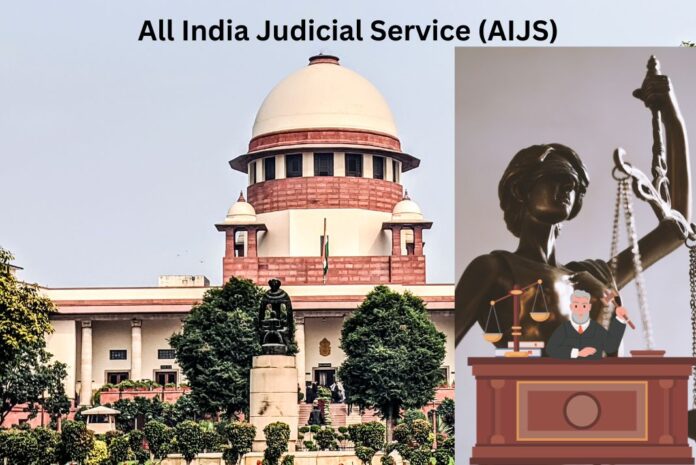The Indian judiciary plays a pivotal role in upholding the rule of law and ensuring justice for all citizens. In recent years, there has been a growing debate surrounding the All India Judicial Service (AIJS), a proposed centralized recruitment system for judges at the level of additional district judges and district judges across all states. This blog post delves into the concept of AIJS, its origins, constitutional basis, need, current status, concerns, and the way forward.
Table of Contents
In news: President Murmu advocates for All India Judicial Service
What is All India Judicial Service (AIJS)?
AIJS is a proposed centralized recruitment system for judges at the level of additional district judges and district judges across all states. Similar to the Union Public Service Commission (UPSC) model, AIJS aims to centralize the recruitment of judges and assign successful candidates to states. The concept of AIJS originated from Law Commission reports in 1958 and 1978, seeking to address structural issues like varying pay, faster vacancy filling, and standardized nationwide training. This idea was revisited in 2006 by the Parliamentary Standing Committee, supporting a pan-Indian judicial service.
Constitutional Basis of All India Judicial Service (AIJS)
Article 312 of the Constitution provides for the establishment of AIJS, similar to central civil services, upon a resolution by the Rajya Sabha supported by at least two-thirds of its members. However, Article 312 (2) states that the AIJS cannot include any post inferior to that of a district judge, as defined in Article 236. According to Article 236, a district judge can include a city civil court judge, additional district judge, joint district judge, assistant district judge, chief judge of a small cause court, chief presidency magistrate, additional chief presidency magistrate, sessions judge, additional sessions judge, and assistant sessions judge.
Need for All India Judicial Service (AIJS)
AIJS proponents advocate for its implementation to address various challenges faced by the Indian judiciary:
Uniform and High Standard of Selection and Training: All India Judicial Service would ensure a standardized selection process and training curriculum for judges, enhancing the overall quality and efficiency of the judiciary.
Filling Vacancies in Lower Courts: AIJS would expedite the filling of vacant positions in lower courts, which currently stand at around 5,400 across the nation. This would help reduce the pendency of cases, which has reached alarming levels.
Increased Representation and Diversity: AIJS would promote a more diverse judiciary, reflecting the social composition of the country by increasing representation from different regions, genders, castes, and communities.
Reduced Judicial Intervention: AIJS would reduce the scope for judicial or executive intervention in judicial appointments, fostering greater independence and accountability of judges.
Improved Career Prospects: AIJS would create a pool of talented and experienced judges who can be appointed to the higher judiciary, improving career prospects and mobility for judges.
Suggested Read: Combating Dark Patterns: India Takes a Stand for Consumer Protection in the Digital Age
Current Status of All India Judicial Service
Despite its potential benefits, the implementation of AIJS remains elusive due to diverging opinions among major stakeholders, including state governments, High Courts, and legal experts. The proposal has been debated for several decades but has not reached the stage of implementation.
How are District Judges Recruited Currently in India?
The current system of appointing district judges is governed by Articles 233 and 234 of the Constitution. States hold the authority over the appointment of district judges, managed through State Public Service Commissions and High Courts. Panels of HC judges interview candidates after the exam and select them for appointment. Judges of the lower judiciary up to the level of district judges are selected through the Provincial Civil Services (Judicial) exam (PCS (J)).
Concerns Regarding AIJS
Opponents of AIJS raise concerns about its potential impact on the federal structure and the autonomy of states and High Courts. They argue that AIJS would:
Infringe Upon Federal Structure and Autonomy: AIJS could undermine the federal structure of India by centralizing the recruitment of judges, potentially diminishing the autonomy of states and High Courts.
Create Conflict of Interest: AIJS could create a conflict of interest and a dual control over judges, who would be accountable to both the central and the state governments.
Disregard Local Nuances: AIJS might overlook the local laws, languages, and customs of different states, which are crucial for the effective functioning of the judiciary.
Affect Morale of Existing Judicial Officers: AIJS could negatively impact the morale and motivation of existing judicial officers, potentially affecting their career advancement.
Suggested Read: Combating Dark Patterns: India Takes a Stand for Consumer Protection in the Digital Age
Way Forward
To address concerns and garner support for AIJS, the following steps could be considered:
Facilitating Dialogues and Consultations: Engaging in open dialogues and consultations with states, High Courts, and legal experts is essential to understand concerns and build consensus.
Sources: indiankanoon.org/doc/1306191/
Watch This:
Related FAQs:
What is the structure and composition of Indian Judiciary?
The Indian judiciary is a three-tiered system, comprising the Supreme Court of India, the High Courts of India, and the subordinate courts.
The Supreme Court of India is the highest judicial court in India and it has the power to review and overturn any law or court decision that is found to be unconstitutional.
There are 25 High Courts in India, each with jurisdiction over a particular state or group of states.
The subordinate courts are the lowest level of courts in India. They are organized into district courts, sessions courts, and metropolitan courts.
The Indian judiciary is composed of a large number of judges. According to the 2022 Annual Report of the Ministry of Law and Justice, there are over 25,628 judges in India.


